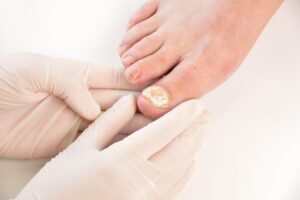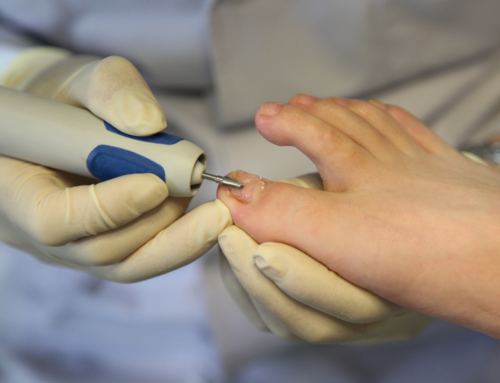Laser toenail fungus treatment in Gulfport can vary. It is important to have all the right information on each treatment option for toenail fungus before you decide what the best treatment option is for you. Our nail doctors are specialists in toenail fungus. They will first consult you. Then they determine if what you have is a toenail fungus infection. Afterward, they explain each treatment option to you and will consult with you on what their best recommendation is for your toenail fungus infection.
Toenail Fungus Symptoms
Toenail fungus, medically known as onychomycosis, often develops gradually and can be easy to overlook in its early stages. One of the first noticeable symptoms is a change in the nail’s appearance. Typically, it begins with a small white, yellow, or brown spot beneath the tip of the nail. As the infection progresses, the discoloration spreads. The nail may become thicker, dull, or brittle, losing its natural shine. The edges of the nail often become ragged or crumbly. In some cases, the nail may start to lift away from the nail bed—a condition known as onycholysis. Patients may also notice an unpleasant odor coming from the affected nail due to fungal buildup and debris trapped beneath it.
As the infection worsens, toenail fungus can cause discomfort or pain, especially when wearing tight shoes or walking. The nail may become distorted in shape, making it difficult to trim. In severe cases, it can even separate completely from the nail bed. The surrounding skin may appear inflamed, scaly, or itchy, particularly if the fungus spreads beyond the nail area. Multiple toenails can be affected at once, and because the condition is contagious, it can spread to other nails. It spreads through shared nail tools, shoes, or floors in communal areas like gyms or pools. Without treatment, the infection can persist for years, leading to ongoing discomfort and cosmetic concerns. Recognizing these symptoms early and seeking proper medical care can help prevent progression and improve treatment success.

Types of Toenail Fungus
Toenail fungus, or onychomycosis, can develop in several different forms. This depends on the type of fungus involved and how the infection spreads through the nail. The most common type is distal subungual onychomycosis. It occurs when dermatophyte fungi invade the nail bed from the tip or sides of the nail. This form typically begins with a yellow or white spot near the edge of the nail. It then gradually spreads inward, causing the nail to thicken, discolor, and crumble at the edges. Because it affects the underside of the nail, it can be difficult to treat and often requires long-term therapy.
Another type, known as white superficial onychomycosis, is caused by fungi that attack only the surface of the nail plate. This results in white, chalky patches on the nail’s surface that can often be scraped away. It tends to progress more slowly. It is usually easier to treat since the infection does not penetrate deeply into the nail.
A less common form is proximal subungual onychomycosis, which begins at the base of the nail near the cuticle and spreads upward as the nail grows. This type is often associated with weakened immune systems. It is also associated with other underlying health conditions and may signal a more serious systemic issue.
Another rare form, candida onychomycosis, is caused by yeast rather than dermatophyte fungi. It typically affects fingernails more than toenails. It causes swelling, redness, or even separation of the nail from the nail bed.
Finally, total dystrophic onychomycosis is considered the end stage of long-standing infection. The nail becomes completely discolored, thickened, and deformed. Recognizing the specific type of toenail fungus is important because it helps determine the most effective treatment. Whether it is topical, oral, or laser-based, it improves the likelihood of achieving clear, healthy nails.
How does toenail fungus spread?
Toenail fungus infections typically begin when fungal organisms—most often dermatophytes—enter the nail. They enter through small cracks, cuts, or separations between the nail and nail bed. These microscopic fungi thrive in warm, moist environments. These places include locker rooms, public showers, gyms, and swimming pools, making these places common sources of infection.
Once the fungus takes hold, it feeds on the keratin in the nail, gradually spreading deeper. It then causes discoloration, thickening, and brittleness. Wearing tight, closed-toe shoes for long periods can trap heat and moisture, creating ideal conditions for fungal growth. People who frequently wear sweaty socks, share nail tools, or walk barefoot in damp public areas are at higher risk of developing toenail fungus.
The infection can also spread from one nail to another or from the skin to the nail. For example, when a person already has athlete’s foot, the same fungi that cause athlete’s foot can easily move to the toenails if not treated promptly. Sharing personal items such as nail clippers, towels, or shoes can also transmit the infection to others.
Additionally, individuals with certain health conditions, like diabetes, poor circulation, or weakened immune systems, are more susceptible. This is because their bodies have a harder time fighting off fungal growth. Once infected, toenail fungus can be persistent and slow to clear, since nails grow slowly. And it provides a tough barrier that protects the fungus. Proper hygiene, wearing breathable footwear, and avoiding shared tools or damp environments can greatly reduce the risk of spreading or contracting toenail fungus.

Laser Toenail Fungus Treatment in Gulfport
If you have caught nail fungus, it can be easily treated using the FDA-approved PinPointe laser, which typically only takes one treatment. Other treatments, like topical solutions and oral medication, are not as effective. Topical solutions have a very low cure rate. This is because the solution does not penetrate all the way through the nail bed. Oral medication has a higher cure rate than topicals, but our nail doctors do not recommend it. This is because it can lead to liver toxicity. You would need to have consistent blood tests throughout the course of taking the medication.
Our nail doctor in Gulfport, MS, recommends this treatment for toenail fungus. The PinPointe Laser treatment has the highest cure rate in the market. It has no side effects and no recovery period. As a result, you can go about your daily activities right after the treatment. Also, there’s no pain.
If you have any signs of nail fungus, call us at 800-672-0625 at our Gulfport, MS location, or visit our website for more information on our doctors at one of our over 150 locations.




